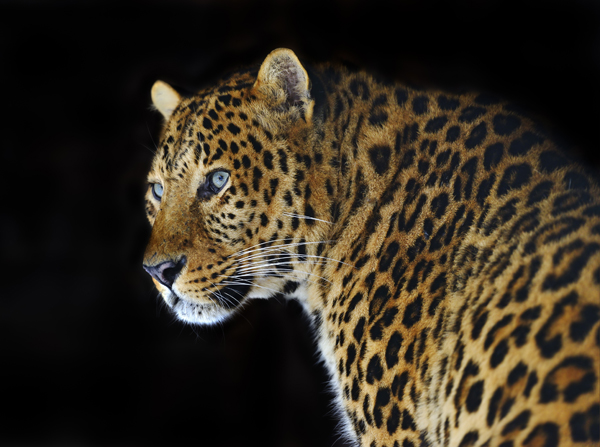“Secretive, silent, smooth and supple as a piece of silk, he is an animal of darkness, and even in the dark he travels alone.”
Interesting Facts About LeopardS
The leopard description by Maitland Edey captures the very essence of the cat. The smallest of the four big cats, the leopard is elusive, solitary and proficient at living in the shadows of its larger cousins the tiger and the African lion. Leopards are also adept at surviving in environments occupied by humans but live secretive lives rarely seen making the cat difficult to observe and complicating the ability to make population estimates across Africa.
Body size and color patterns vary geographically and probably reflect adaptations to the different habitats. They have short legs relative to their long body and a broad head with powerful jaw muscles. The big cats’ scapula is uniquely attached to its muscles allowing the spotted cat to be a more proficient at climbing. The leopard also has a unique locking wrist that allows for adept tree climbing. Leopards have small round ears, long whiskers extending from dark spots on the upper lip and long whiskers in their eyebrows that protect their eyes while moving through dense vegetation.
The Leopard’s Unique Coat
The leopard’s coat ranges from tawny or light yellow in warm, dry habitats to reddish orange in dense forests. There are nine subspecies of Leopards (Panthera pardus). Subspecies are distinguished by unique pelage characteristics. Their body is covered with black rosettes, which are circular in East Africa and square in South Africa. Leopards have solid black spots on their chest, feet, face and rings on their tail. Each individual leopard has a unique coat, and this unique coat is often used for identification. Black panthers, which are often found in humid forests, are leopards with recessive melanistic genes.
The Most Versatile of the Big Cats
The leopard has the widest habitat tolerance of any Old World Felid, making it the most versatile of the big cats. The leopard’s wide range and ability to survive in areas where other large carnivores have been extirpated has given the impression that the leopard’s conservation status is secure and therefore leopards are often given a lower conservation priority than the tiger and the African lion.
The leopard may be adaptable but not invincible. They are now extinct in North Africa, have vanished from most of the West African coastal belt and continue to decline outside of protected areas in most of East and southern Africa. Much like their big cousins the tiger and the African lion, leopards are also one of the most persecuted big cats as a result of retaliatory killing by livestock owners, poorly managed trophy hunting, and for fur and body parts for the commercial trade in Asia. All three species of cats are victims of loss of habitat, and depletion of natural prey but the leopard is the most resilient in the face of human pressure.
The Highly Adaptable Big Cat
But the leopards resilience in the face of human pressure may be because the spotted cat is being squeezed into a buffer zone closer and closer to human settlements yet away from the larger cats in an effort to avoid confrontation with the tigers and lions that share their habitats. The leopards ability to remain elusive in a crowded landscape may be the result of the cat’s instinct to remain under the radar when there are top predators nearby.
A recent study* of the movement patterns of collared individuals revealed the cats ability to slip in and out of human dominated landscapes, even slinking by very close to occupied houses under the cover of darkness. During the day when human activity was the highest, the leopards restricted their movements to areas further away form the houses. Further study is required, but it appeared that the leopards took cover in areas of tall crops, such as sugar cane or patches of scrub to avoid human contact.
This study highlighted the cat as a highly adaptable species with an excellent ability to use resources available in human dominated areas. India has strict laws to prevent the killing of large cats, even after livestock are killed. The rural people are also far more tolerant than those in other parts of the world and accept the presence of the big cats in their landscapes. On several occasions, the collared leopards were seen by people and even chased by people, yet no fatal attacks occurred.
Human and Leopards Living Together
The low natural prey density is the result of human pressure on the environment implying that a degree of conflict is inevitable due to lack of alternatives to domestic animals for food. If leopards can be saved in human dominated landscapes, it is important to effectively mitigate conflict by increasing tolerance of the big cats. This study shows that a viable natural prey base is not always necessary for sustaining leopards in an area, but it might affect the number of livestock depredation events.
This study, although the sample size was small, made an important contribution to the sparsely published data on leopard movements. A better understanding of this elusive cat will enable better conservation strategies.
*Odden M, Athreya V, Rattan S, Linnell JDC (2014) Adaptable Neighbours: Movement Patterns of GPS-Collared Leopards in Human Dominated Landscapes in India. PLoS ONE 9(11): e112044. doi:10.1371/journal.pone.0112044
McGonagle, J. (2011) The Adaptable Leopard: Why the Leopard May Be Better Suited for Survival in a Crowded Landscape than the Lion and Tiger. Issues in Evolution. Miami University.


Well done. Lots of good information. Stunning photo.
Excellent post Joanne, I thoroughly enjoyed reading this. How sad that the Amur is near extinction. I applaud the people of India for working towards co-existence with the big cats. Laura
Happy Valentines Day to your crew ??
What a wonderful article, I didn’t know a lot about this cat, this was great information. Thank you for sharing 🙂